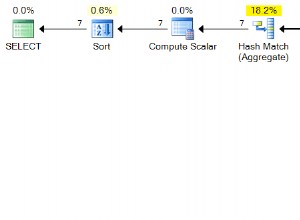Desafio aceito;)
Eu não acho que haja alguma maneira de fazer isso apenas com o mecanismo de sequência do PostgreSQL ( 1 ) Mas se você realmente precisa de algo assim (e estou bastante interessado em saber por que você precisa de algo assim), você pode fazer uma função que retorna o próximo valor desejado e colocá-lo em um gatilho.
Por exemplo, crie uma tabela primeiro:
create table test (test_id varchar);
Use uma função como esta abaixo
create or replace function next_id_test()
returns trigger language plpgsql as $function$
begin
with cte_conform_char_list as
(
select val, row_number() over (order by val), lead(val) over (order by val)
from (values ('A'), ('B'), ('C'), ('D'), ('E'), ('F')) as t(val) -- you can continue this list as much as you want it ;)
order by 1
)
, cte_built_char_list as
(
select
cte.val
, cte.row_number
, coalesce(cte.lead, cte_2.val) as next_char
from cte_conform_char_list cte
left outer join cte_conform_char_list cte_2
on cte_2.row_number = cte.row_number - (select max(row_number) from cte_conform_char_list) +1
)
select
case
when row_number < (select max(row_number) from cte_built_char_list)
then repeat(next_char, cast(rank() over (partition by row_number order by test_id) as int))
else repeat(next_char, cast(rank() over (partition by row_number order by test_id) + 1 as int))
end as next_test_id into new.test_id
from test T
inner join cte_built_char_list cte on substring(T.test_id from 1 for 1) = cte.val
order by char_length(test_id), test_id;
return new;
end;
$function$;
Anexar a função a um gatilho anterior
create trigger tg_test before insert on test for each row execute procedure next_id_test();
Insira um valor que realmente não importa (ele será alterado de qualquer maneira)
insert into test values ('ttt');
Então você pode observar que você tem o caráter certo.
select *
from test;
Eu sei que é um pouco pesado, mas não vejo nenhum outro. A função provavelmente não é perfeita, mas não tenho muito tempo :)
Espero que te ajude;)




